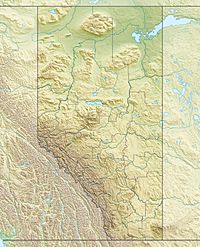Mount Hooker (Canada) facts for kids
Quick facts for kids Mount Hooker |
|
|---|---|
| Highest point | |
| Elevation | 3,287 m (10,784 ft) |
| Prominence | 540 m (1,770 ft) |
| Geography | |
| Location | Alberta British Columbia |
| Parent range | Park Ranges |
| Topo map | NTS 83D/08 |
| Climbing | |
| First ascent | 1924 by Alfred J. Ostheimer, M.M. Strumia, J. Monroe Thorington, guided by Conrad Kain |
Mount Hooker is a majestic mountain located right on the border between two Canadian provinces: Alberta and British Columbia. It stands tall in the Canadian Rockies, a famous mountain range known for its stunning beauty.
This impressive peak was given its name in 1827 by a Scottish botanist and explorer named David Douglas. He named it after his friend, William Jackson Hooker, who was a very important botanist. For many years, people believed Mount Hooker, along with its neighbor Mount Brown, were the tallest mountains in the entire Canadian Rockies. This belief led to some interesting stories and explorations, which you can read more about in the article Hooker and Brown.
Contents
Mount Hooker: A Canadian Giant
Mount Hooker reaches an impressive height of 3,287 meters (about 10,784 feet) above sea level. This makes it one of the many "three-thousanders" in the region, which are mountains over 3,000 meters tall. Its location on the provincial border means it's a landmark for both Alberta and British Columbia.
Where is Mount Hooker Located?
Mount Hooker is part of the Park Ranges, which is a sub-range within the larger Canadian Rockies. It sits in a wild and beautiful area, surrounded by other peaks and vast wilderness. Its exact spot is marked by its coordinates: 52°24′21″N 118°05′35″W. These numbers help pinpoint its location on a map, much like an address for a house.
Who Was William Jackson Hooker?
The mountain was named after Sir William Jackson Hooker (1785–1865). He was a very famous British botanist, which means he studied plants. He was the first director of the Royal Botanic Gardens, Kew, in England. This garden is one of the most important botanical research and education centers in the world. David Douglas, the explorer who named the mountain, sent many plant samples back to Hooker for him to study. Naming the mountain after him was a way to honor his important work.
Early Explorers and Tall Tales
For a long time, people thought Mount Hooker and Mount Brown were much taller than they actually are. Early explorers, like David Douglas, estimated their heights to be incredibly high, even taller than some of the highest peaks in the world at the time. This was partly because they were seen from far away and looked very imposing. These early, incorrect measurements led to a lot of excitement and debate among geographers and explorers. It wasn't until more accurate surveys were done later that the true heights of these mountains were known. This story shows how challenging it was to map and measure mountains in the past without modern tools!
First Climbs to the Summit
Reaching the top of Mount Hooker is a challenging adventure. The first recorded climb to its summit happened in 1924. The climbing team included Alfred J. Ostheimer, M.M. Strumia, and J. Monroe Thorington. They were guided by a very famous and skilled mountain guide named Conrad Kain. Kain was known for his incredible climbing abilities and for leading many first ascents in the Canadian Rockies. Their successful climb marked an important moment in the exploration of this part of the mountains.
Mount Hooker continues to be a significant landmark in the Canadian Rockies, reminding us of both its natural grandeur and the history of exploration and discovery in Canada.


